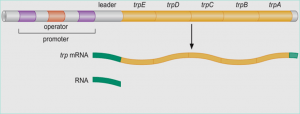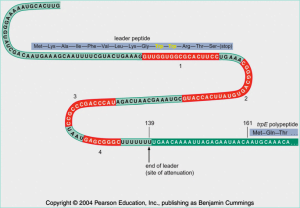Example of Gene Regulation at steps after Transcription initiation.
Where translation is coupled with transcription to achieve regulation of an operon through secondary RNA structure.
To which process the figure given below is related?



trp Operon is a Repressible Operon
trp operon, just like many other operons for amino acid biosynthesis, responds to the cellular level of amino acid, here Tryptophan.
The operon is switched off whenever cellular level of tryptophan is high (repressible).
The E.colitrp operon is regulated at two levels ØBlocking the transcription initiation via repressor-operator interaction.
ØAttenuation
Attenuation is the regulation of bacterial operons by controlling termination of transcription at a site located before the first structural genes.
Most of the amino acid bio synthetic pathways are regulated by attenuation.
The attenuation is based on the ability of RNA to form alternative structures through intra-molecular base pairing.
In E.coli, the attenuation requires close link between transcription and translation.
The trp Operon

Structural Genes of trp Operon
trpE : Anthranilate Synthase Component I
trpD : Anthranilate Synthase Component II
trpC : N- (5’-Phosphoribosyl)-Anthranilate Isomerase Indole 3Glycerol Synthase.
trpB : Tryptophan Synthase β subunit
trpA : Tryptophan Synthase α subunit
Together these enzymes catalyze formation of tryptophan from chorismate.
Trp Repressor
Trp Repressor is a homodimer, each subunit containing 107 aa residues. The DNA binding domain is helix turn helix motif.
When tryptophan is abundant, it binds to the trp repressor causing a conformational change that permits the repressor to bind to trp operator and block transcription.
The trp operon site overlaps the promoter and binding of the repressor blocks binding of RNA Polymerase.
At low tryptophan levels, the repressor loses tryptophan and falls off from the operator.
Once Repression is lifted and transcription begins, the rate of transcription is fine tuned by a second regulatory process called Transcription Attenuation

Sequence of the 5’ end of the trp operon mRNA revealed that 161 ntds RNA is made from the trp promoter before RNA polymerase encounters the first codon of trpE.
Analysis of this sequence shows the region coding for a short peptide (leader peptide), and a transcription terminator (Attenuator) towards the end.
Further more the sequence can be divided into 4 regions that can form alternate structures by base pairing.

The leader peptide has two Trp codons in a row within region 1.
Region 1 and Region 2 can base pair.
Region 3 and Region 4 can base pair : Termination loop forms and Transcription termination at attenuator (Poly U sequence) occurs.
Alternatively region 2 can base pair with region 3 : termination loop not available and transcription proceeds past attenuator to trp genes.

When trp level are high,
charged trp tRNAs are available for ribosome that is translating the just transcribed trp mRNA, and ribosome can move forward and covers the region 2. As the polymerase transcribes region 3 and region 4, they are available for base pairing and form termination loop. The result is that transcription terminates at attenuator before the first structural genes and hence are not transcribed.
When trp levels are low,
charged tRNAs are not available for ribosome that is translating the nascent 5’end of trp operon mRNA.
Hence the ribosome stalls for a while at region 1, making region 2 available to base pair with region 3 as it is transcribed. When this happens terminator loop of region 3:4 cannot form allowing the polymerase to move past attenuator to transcribe structural genes for tryptophan biosynthesis.
Leader sequence of leu operon has four consecutive codons for leucine. Leader sequence of his operon has seven codons for histidine on the trot. In fact, leu operon and his operon rely solely on attenuation to regulate the biosynthesis of the respective amino acids.